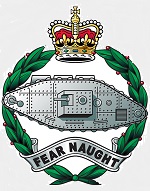Hobby Master HG3604 British M24 Chaffee Light Tank - C Squadron, Recon Regiment, 5th Infantry Division, 1946 (1:72 Scale)
"From Stettin in the Baltic to Trieste in the Adriatic, an iron curtain has descended across the Continent. Behind that line lie all the capitals of the ancient states of Central and Eastern Europe. Warsaw, Berlin, Prague, Vienna, Budapest, Belgrade, Bucharest and Sofia, all these famous cities and the populations around them lie in what I must call the Soviet sphere, and all are subject in one form or another, not only to Soviet influence but to a very high and, in many cases, increasing measure of control from Moscow."
- Excerpted from British Prime Minister Winston Churchill's "Sinews of Peace" speech delivered at Westminster College, in Fulton, Missouri, March 5th, 1946
 The M24 Chaffee - arguably the best light tank of World War II - was a fast, lightly armored vehicle with the ability to deliver relatively large caliber direct fire thanks to its excellent 75 mm M6 gun. More than 4,000 vehicles were produced by Cadillac and Massey-Harris from 1943-45. The first vehicles reached Europe in late 1944, where they proved very effective and highly reliable. At the outset of the Korean War, however, American forces equipped with the M24 Chaffees performed poorly against the enemy's T-34/85s, and these US units were soon augmented with M26 Pershings and M46 Pattons, along with M4A3E8 Shermans armed with the long 76mm gun. The Chaffee remained in American service until 1953, at which time it was eventually replaced by the M41 Bulldog.
The M24 Chaffee - arguably the best light tank of World War II - was a fast, lightly armored vehicle with the ability to deliver relatively large caliber direct fire thanks to its excellent 75 mm M6 gun. More than 4,000 vehicles were produced by Cadillac and Massey-Harris from 1943-45. The first vehicles reached Europe in late 1944, where they proved very effective and highly reliable. At the outset of the Korean War, however, American forces equipped with the M24 Chaffees performed poorly against the enemy's T-34/85s, and these US units were soon augmented with M26 Pershings and M46 Pattons, along with M4A3E8 Shermans armed with the long 76mm gun. The Chaffee remained in American service until 1953, at which time it was eventually replaced by the M41 Bulldog.
After 1945, the M24 Chaffee was used by many American allies. The French army used them in Indo-China, including at the battle of Dien Bien Phu. Though obsolete by the mid-1960's, it remains in service in some client nations.
Pictured here is a 1:72 scale British M24 Chaffee light tank that was attached to C Squadron, Recon Regiment, 5th Infantry Division, during 1946.
Sold Out!
Dimensions:
Length: 4-inches
Width: 1-1/2-inches
Release Date: December 2008
Historical Account: "Globe Trotting" - In September 1939, the 5th Infantry Division was a regular formation in the UK. Both its infantry brigades went to France by early October as independent infantry brigades, but Divisional Headquarters crossed to France on December 19th and by the new year the Division was reformed.
The 5th Infantry Division saw action in France and Belgium in 1940 including at the Ypres-Comines Canal from 26th to 28 May 1940, and then was withdrawn, along with the rest of the British Expeditionary Force, from Dunkirk. After this it served and travelled in so many regions of the world that they became known as the Globe Trotters. In April 1942, 13th and 17th Infantry Brigades and a portion of the Divisional Troops were detached to 'Force 121' for Operation Ironclad, the invasion of Vichy French held Madagascar. The Division was not complete again until August 1942. It was sent from the UK to India to Iraq, and Persia to join the Tenth Army, where it spent time under the command of III Corps and XXI Indian Corps. It then went to Syria and Egypt before being withdrawn in preparation for the Sicily landings.
The 5th Division saw action in the Sicily Landings from July 9th - 12th, 1943, and then was part of the British Eighth Army in Italy. Under XIII Corps, it was in the Messina area in September 1943, involved in the Sangro battles from Nov. 19th to Dec. 3rd, 1943, engagements at Garigliano Crossing from January 17th - 31st, 1944.
After the British 1st Infantry Division and other British forces, as part of the U.S. VI Corps under Major General John P. Lucas, landed at Anzio in January 1944, the 5th Division was part of later reinforcements sent there, along with the 56th (London) Infantry Division.
It was part of the drive on Rome from May 22nd to June 4th, 1944. From there they were sent to Palestine, back to Italy and finally to North West Europe for the final months of the war.
During World War II, unlike during World War I, the Division used a 'Y' on a black square background as its insignia.





 General review
General review 








![US M65 Atomic Cannon Heavy, Motorized - "Atomic Annie" [Firing Mode] (1:72 Scale)](http://cdn4.volusion.store/qh9e9-jdqv9/v/vspfiles/photos/DRR63160-1.jpg?v-cache=1740197136)
